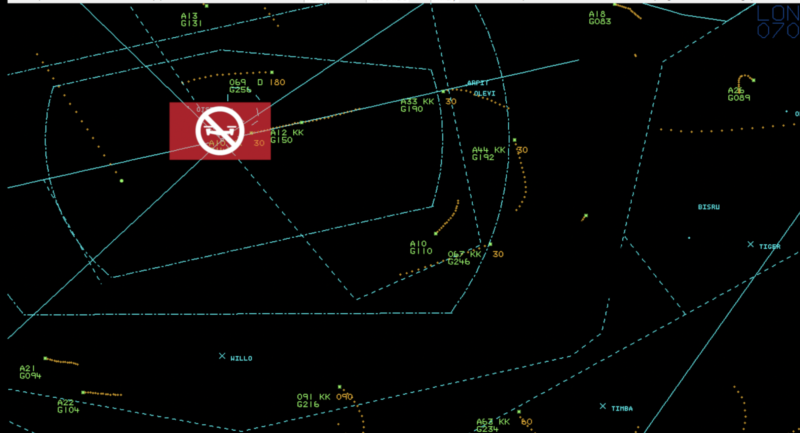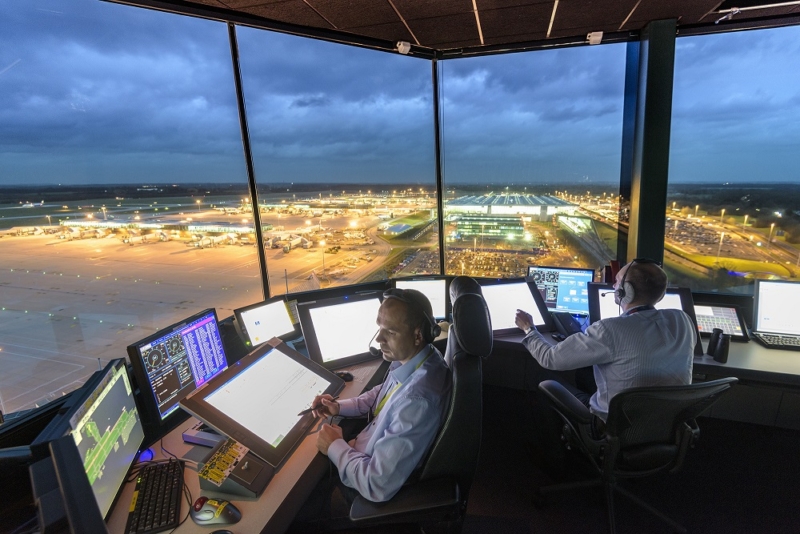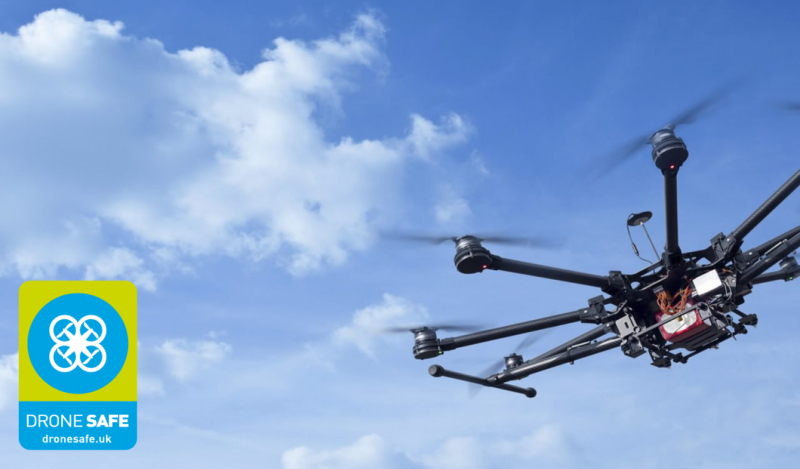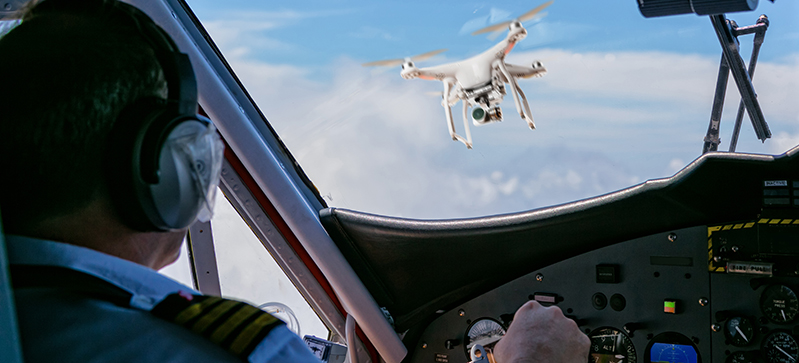Drone disruption at Gatwick
5 July 2017Sunday’s incident at Gatwick, where a drone spotted on the airport’s final approach path caused the runway to be closed for two separate periods, has understandably received a lot of press coverage.
The incident caused significant knock-on effects for air traffic control, beyond just stopping arrivals while the runway was closed and caused serious disruption in the sky above southern England.
It is always the airport’s decision whether to close the runway to arriving aircraft. Safety is always going to be the number one priority and Gatwick was left with little choice on this occasion, given the location of the drone.

The location of the drone meant Gatwick had to temporarily close its runway
Our job is to work with the airport to manage and minimise the disruption caused by such a closure. This is no small challenge when you’re talking about the world’s busiest single runway airport in some of the world’s busiest airspace, particularly during a busy summer weekend. I was in the Operations Room when the call came in on Sunday.
Our first job was to divert aircraft coming into land away from the runway. This meant tactically manoeuvring aircraft to avoid the runway, which significantly increases controller workloads. This is where a controller’s extensive training really comes to the fore, managing multiple aircraft in a relatively confined area of airspace…and keeping them safely separated at all times.
We directed the aircraft back to the two holds that support Gatwick – one called Timba to the South East of the airport and another called Willo to the South West. You can see this in the radar replay footage below. With the runway closed, these holds soon started to fill up and it wasn’t long before we had to open the contingency hold – Mayfield – as well.
The next challenge is dealing with any required diversions as aircraft continue to burn fuel whilst they wait to land. Airlines carry a set amount of fuel for their scheduled journey, with a contingency amount for unforeseen circumstances, but after a while spent burning fuel in the hold and without knowing when a runway is going to re-open and, pilots have to consider whether diverting to an alternative airport is the safest option. On Sunday, four aircraft had to divert – one to Stansted, one to Southend and two to Bournemouth.
At the same time, we were also looking at other ways to slow the flow of arriving aircraft in to the airport. This included introducing an ‘en-route’ hold near the Solent, with some aircraft held far away from the airport and at higher altitudes while they waited for the backlog to clear. This saved clogging up the airspace immediately around the airport even further, as well as reducing fuel-burn for aircraft as the en-route holds at higher levels are less fuel-intensive than the standard arrival holds.
We also had to place a flow regulation on arriving aircraft, which led to aircraft due to depart for Gatwick from elsewhere delaying their take-offs.
The disruption was significant and took hours to clear; it was around midnight before everything was fully ‘back to normal’ and even then, hundreds of passengers had ended up away from their intended airport and thousands of passengers had been delayed. All as a result of one drone pilot flouting the rules.
Drone users have a responsibility to others in the air, just as any other pilots do. It’s their responsibility to fly safely and to respect other users of the airspace. It’s hard to imagine this drone pilot didn’t know that what he was doing would disrupt the airport’s operations.
If you know anyone who’s planning to fly a drone, please, make sure they read the CAA Dronecode and download the Drone Assist app before they fly so that they fly safely.
Comments
Please respect our commenting policy and guidelines when posting on this website.




06.07.2017
07:50
Justin Moorhouse
What a kerfuffle! And what an over-reaction and waste of money, someone with a toy defeating the technological might of NATS and wasting millions in airlines’ costs and travellers’ time. NATS obviously knew where the drone was, they know the radio frequency it was operating on, why not just transmit a jamming signal, cause it to unbind and let it return to home? They have bird-scarers, why not drone-scarers?
06.07.2017
11:22
Andrew
Who did the call come from (pilot. member of the public etc) and what was the description and altitude?
06.07.2017
12:44
Stan L
I wouldnt describe the possible loss of hundreds of lives a Kerfuffle. Drone sales should be banned as the serve no other purpose than toys. Flying one of these things near an airport is attempted murder and the culprits should be punnished accordingly.
06.07.2017
13:18
Clive Williams
Justin Moorhouse thinks its a kerfuffle and over-reaction! Apparently its not the fault of the perpetrator but the victims for not defending themselves from the idiots. Its a good job he’s not a judge or we’d be overrun with rapists and murderers. Put ‘bird strike damage photos’ into Google. If a bird can do that imagine what a drone can do.
06.07.2017
13:51
Paul Britton
Has it actually been proven that it was a drone yet? Has the craft and it’s pilot been found?
06.07.2017
15:05
Anthon Brits
Can someone please explain what is meant by the drone was “Spotted” Did they have a visual? Also I would like to know if a bird is “Spotted”, do you follow the same procedure?
06.07.2017
17:45
Adam Gooch
How is it conformed as a drone? Was it actually found? Or is it an assumption being reported as fact?
07.07.2017
01:55
Paulo
Anthon Brits There is a difference between a bird and a drone… intent. It’s pretty desperate that this needs spelled out to people.
The ATC has to ask.. why is the drone there, who might be flying it, what might their intention be? Responsible, corporate or industrial users would have consulted with the tower and advised them of their flight plan and times, say if there was a power cable survey or similar going on. The ATC would be aware and be able to disregard the craft as any kind of threat to safety..
An unknown aircraft might just be some hopelessly stupid civilian, or it could be somebody trying to use the drone to strike or obstruct another aircraft.
The unknown bit is the key. You can be pretty sure a pigeon doesn’t have any malicious intent. And if flesh, feathers and bone can bring an aeroplane down in the Hudson River what could the metal airframe of a drone do?
Can you image the furore if landings had been permitted to continue and a drone strike occurred?
Hopefully it was just an idiot, and hopefully the GPS log will betray their registration details and they can be made an example of.
Responsible drone users would be better served condemning this users stupidity than questioning the judgement of the NATS ATC, who’s main priority is safety.
Like driving a car, using a drone is a privalege. The CAA have tried to strike a balance between recreational freedom and responsible use. Incidents like this are just fuel to the flames of those who would ban drones.
Justin Moorhouse – some drones operate via wifi rather than radio. My take in this instance that it is the technological might of NATS that was able to identify the risk, take appropriate action and then eliminate the risk. Blame the irresponsible drone pilot, not NATS. No drone in controlled airspace = no issue. It sounds to me like a custom build drone, as most of the off the shelf drones have GPS with proscribed no fly zones. Your average muppet with a phantom could not have taken off within the control zone, or have flown into it. If anybody in the drone community has information it is incumbent that they come forward, as idiots like this will ruin the hobby for all the responsible drone users.
07.07.2017
09:05
Carolina
I think there is a clear case for NATS to get involved in the investigation of technology that can keep a drone free perimeter around the airport. I have mentioned this before to a few people who looked at me like I was mad (maybe is a silly idea, I don’t know). There are already 3 British companies that are trialling their signal jamming technology at USA airports and working with the FAA. Why leave it to someone else? This is something that affects NATS operations directly and a good opportunity to develop the business and keep the skies safe. Just saying….
07.07.2017
12:13
Phil Binks
Solution ArchitectHello all – thank you for the comments so far.
The drone sighting on Saturday was reported to Gatwick Airport and it was they who made the decision to suspend arrivals due to completely understandable safety concerns. Air traffic radars are not always able to see drones as radars tend to be tuned to seeing much larger and faster moving objects.
You’re correct in saying there are a limited number of frequencies drones can use, therefore in theory it should be relatively easy to ‘jam’ the signal. However, jamming is an illegal activity. A number of companies have developed solutions that exploit the link between the operator and the drone.
Although legal in some parts of the world, Ofcom have deemed the activity illegal. There are other possible solutions; audio, optical, special radars, auto-triangulation capabilities, but there is no one, simple quick fix solution.
12:13
Phil Binks
Solution Architect08.07.2017
16:43
Andy Hay
I’m thinking police/military helicopter plus marksman!
09.07.2017
19:15
Tom Wright
Why not approach DJI and get them to apply geolocks around UK airports?
10.07.2017
13:43
Andy
@Tom Wright
They have put in no-fly based on GPS… but they are extremely trivial to bypass, and in any case self-build and a lot of other manufacturers do not have this restriction.
Airports need some kind of seeker drone that follows the original drone back to its owner for identification. It takes a special kind of stupid to fly near an airport, they aren’t just an irresponsible drone flyer. The drone code (drone/boring being operative word) is actually quite difficult to stick to if you want decent pics and want to have an exciting hobby – and i think most will stray outside of the overly restrictive features when the craft is more than capable of safely acheiving it, but not flying in airport no-fly is obvious to anyone with a braincell.
Rather than moaning about every little thing, or tarring all drone flying hobbyists with the bad press and possibly even stupider rules, tracking down the idiots round airports needs to be taken seriously.
10.07.2017
13:43
Richard
Tom Wright, DJI do apply very strict geofencing to all their UAVs. The firmware is updated regularly with new restrictions and lifted restrictions too. There is, however, a very irresponsible and active community(worldwide, this isn’t just a UK issue) that insist in ‘jailbreaking’ dji UAVs taking out the NFZs (no fly zones) and lifting all the other restrictions in the firmware, like max altitude is 120mtrs(400ft) above ground level(AGL) and 500mtrs distance. DJI have declared war on these people though and are removing older, more vulnerable firmware versions from their website so people cant ‘roll back’ firmware and writing in many more hacking protections. Its only a matter of time before it gets cracked again though, these people( although dangerous and stupid) are very intelligent.
20.12.2018
12:10
John Ridge
In light of the recent unwanted drone activity at Gatwick airport (Dec 2018) and the significant conseqential impact on air traffic control, related business operations and the well being of wider society, is it now not time for the UK government to work with NATS to send a clear message to the nation and any visitors to the United Kingdom that we will take a zero tolerance stance on unwanted drone activity. The risk and hazards to the economy, the security and reputation of the nation far outweighs any benefits associated with unwanted drone activity. Further customs and excise and security services should now work to eliminate the import and use of drones for anything other than a highly defined controlled purposes; military systems should be developed and deployed in and around airports to mitigate the effect of unwanted drone activity and Ofcom restrictions which currently make it illegal to jam drone control signal frequencies should be lifted with immediate effect for authorised actors.